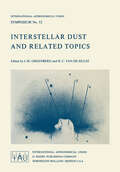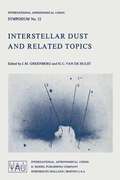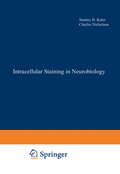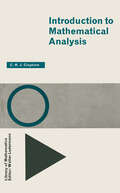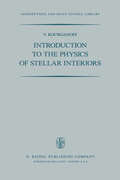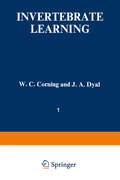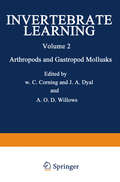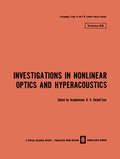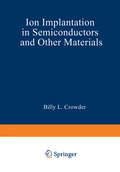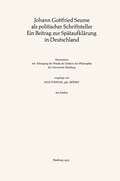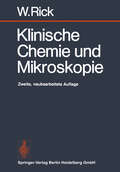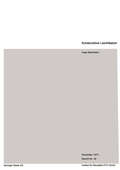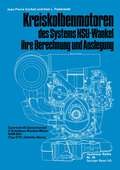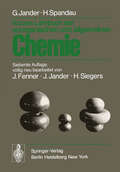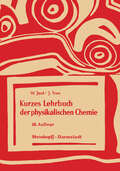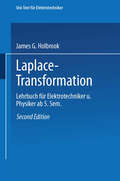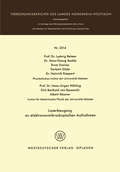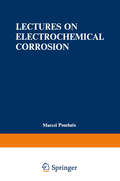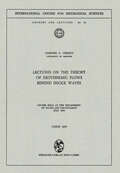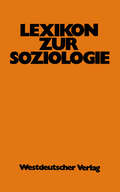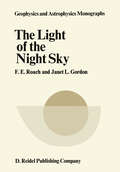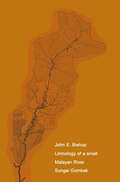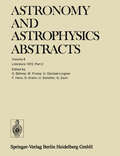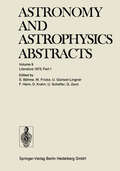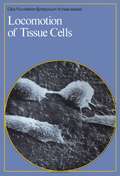- Table View
- List View
Interstellar Dust and Related Topics (International Astronomical Union Symposia #52)
by J. Mayo Greenberg H. C. HulstIAU Symposium Number 52 on Interstellar Dust and Related Topics was held at Albany, N.Y., on the campus of the State University of New York at Albany from May 29 to June 2, 1972. The members of the Organizing Committee were: Dr A. D. Code, University of Wisconsin, Madison, Wis., U.S.A. Dr B. D. Donn, Goddard Space Flight Center, Greenbelt, Md., U.S.A. Dr A. Elvius, Stockholm Observatory, Saltsjobaden, Sweden. Dr T. Gehrels, Lunar and Planetary Laboratory, University of Arizona, Tucson, Ariz., U.S.A. Dr J. M. Greenberg (Chairman), State University of New York at Albany, Albany, N.Y., U.S.A. Dr H. C. van de Hulst, Sterrewacht, Leiden, Holland. Dr S. B. Pikel'ner, Sternberg Astronomical Institute, Moscow, U.S.S.R. Dr E. E. Salpeter, Cornell University, Ithaca, N.Y., U.S.A. Dr B. E. Turner, National Radio Astronomy Observatory, Charlottesville, Va., U.S.A. The suggestion was first made in 1971 that a symposium on interstellar grains would be timely. The response to the first preliminary announcement, which was sent out on November 29, 1971, was well beyond our expectations. The meeting was locally sponsored by the State University and by Dudley Observatory. The National Aeronautics and Space Administration and the National Science Foundation con tributed along with the IAU. There were 158 participants of whom 49 were from 15 countries outside the United States. A total of 92 papers were presented.
Interstellar Dust and Related Topics (International Astronomical Union Symposia #52)
by J. Mayo Greenberg H. C. Van De HulstIAU Symposium Number 52 on Interstellar Dust and Related Topics was held at Albany, N.Y., on the campus of the State University of New York at Albany from May 29 to June 2, 1972. The members of the Organizing Committee were: Dr A. D. Code, University of Wisconsin, Madison, Wis., U.S.A. Dr B. D. Donn, Goddard Space Flight Center, Greenbelt, Md., U.S.A. Dr A. Elvius, Stockholm Observatory, Saltsjobaden, Sweden. Dr T. Gehrels, Lunar and Planetary Laboratory, University of Arizona, Tucson, Ariz., U.S.A. Dr J. M. Greenberg (Chairman), State University of New York at Albany, Albany, N.Y., U.S.A. Dr H. C. van de Hulst, Sterrewacht, Leiden, Holland. Dr S. B. Pikel'ner, Sternberg Astronomical Institute, Moscow, U.S.S.R. Dr E. E. Sal peter, Cornell University, Ithaca, N.Y., U.S.A. Dr B. E. Turner, National Radio Astronomy Observatory, Charlottesville, Va., U.S.A. The suggestion was first made in 1971 that a symposium on interstellar grains would be timely. The response to the first preliminary announcement, which was sent out on November 29, 1971, was well beyond our expectations. The meeting was locally sponsored by the State University and by Dudley Observatory. The National Aeronautics and Space Administration and the National Science Foundation con tributed along with the JAU. There were 158 participants of whom 49 were from 15 countries outside the United States. A total of 92 papers were presented.
Intracellular Staining in Neurobiology
by Stanley B. Kater Charles NicholsonThe purpose of this book is to provide basic reference material to facilitate the further development and application of the intracellular staining techniques which originated with the introduction of Procion dye as a neurocellular stain. We had sev eral specific objectives in compiling these chapters. First, we recognized that both the techniques and results of intracellular staining have been derived from a variety of preparations and published in diverse journals. Consequently, we tried to make this information more readily available by incorporating several reviews by original authors. This should provide the reader with a knowledge of the kinds of neurobiological prob lems for which intracellular staining has already been employed. A second objective was to facilitate extension of these methods to a wider variety of problems. To this end there are chapters dealing with Procion dye as a marker for ultrastructural investi gations, the use of cobalt as a staining compound and the implementation of computer techniques for quantitative studies of neuronal relationships. As background for further extension of these methods this volume contains material on the history of the discovery of Procion dyes as intracellular stains, the chemistry of these dyes, and fundamentals of fluorescence microscopy. Our final specific objective was to present details of technical procedures that were not readily available in the literature.
Introduction to Mathematical Analysis (Library of Mathematics)
by C. ClaphamI have tried to provide an introduction, at an elementary level, to some of the important topics in real analysis, without avoiding reference to the central role which the completeness of the real numbers plays throughout. Many elementary textbooks are written on the assumption that an appeal to the complete ness axiom is beyond their scope; my aim here has been to give an account of the development from axiomatic beginnings, without gaps, while keeping the treatment reasonably simple. Little previous knowledge is assumed, though it is likely that any reader will have had some experience of calculus. I hope that the book will give the non-specialist, who may have considerable facility in techniques, an appreciation of the foundations and rigorous framework of the mathematics that he uses in its applications; while, for the intending mathe matician, it will be more of a beginner's book in preparation for more advanced study of analysis. I should finally like to record my thanks to Professor Ledermann for the suggestions and comments that he made after reading the first draft of the text.
Introduction to the Physics of Stellar Interiors (Astrophysics and Space Science Library #34)
by V. KourganoffAll astrophysicists are acquainted with the fundamental works ofS. Chandrasekhar [6] and M. Schwarzschild [1] concerning the internal structure of stars. Although both of these works accentuate the principal mathematical devices of the theory (and use, for this reason, notations that are rather perplexing for the non-specialist), the work of Schwarzschild is distinguished by care in demonstrating the physical meaning of the principal equations, while that of Chandrasekhar makes every effort not to skip a single step in the calculations. On the other hand, Schwarz schild , who considers his two introductory chapters as simple reviews of results which are already known, passes a bit rapidly over certain difficult arguments, and Chandrasekhar never goes far enough in the analysis of the physical mechanisms involved. From another point of view, the excellent review articles published in the Ency clopedia of Physics [5] by M. H. Wrubel, P. Ledoux, and others, and those published in Stars and Stellar Systems [4] by H. Reeves, B. Stromgren, R. L. Sears and R. R. Brownlee, and others, are principally intended for research workers who are already initiated into the theory of internal structure. These monographs are on a level that is clearly too high for the general physicist who is approaching these astrophysical questions for the first time, and more particularly for the post-graduate student.
Invertebrate Learning: Volume 1 Protozoans Through Annelids
by William CorningSince the publication of the second volume of Comparative Psychology by Warden, Warner, and Jenkins (1940), there has not been a comprehensive review of invertebrate learning capacities. Some high-quality reviews have appeared in various journals, texts, and symposia, but they have been, of necessity, incomplete and selective either in terms of the phyla covered or the phenomena which were reviewed. Although this lack has served as a stimulus for the present series, the primary justification is to be found in the resurgence of theoretical and empirical interests in learning capacities and mechanisms in simpler systems of widely different phylogenetic origin. Intensive research on the physiological basis of learning and memory clearly entails exploration of the correlations between levels of nervous system organization and be havioral plasticity. Furthermore, the presence of structural-functional differ entiation in ganglionated systems, the existence of giant, easily identifiable cells, and the reduced complexity of structure and behavior repertoires are among the advantages of the "simple systems" strategy which have caused many neuroscientists to abandon their cats, rats, and monkeys in favor of mollusks, leeches, planaria, crayfish, protozoa, and other invertebrate preparations. Behavioral research continues to reveal remarkable capacities in these simple organisms and encourages us to believe that the confluence of the invertebrate learning data with the more voluminous vertebrate litera ture will contribute substantially to the enrichment of all of the neurobe havioral sciences.
Investigations in Nonlinear Optics and Hyperacoustics (The Lebedev Physics Institute Series #58)
by D. V. Skobel’tsynIon Implantation in Semiconductors and Other Materials (The IBM Research Symposia Series)
by Billy CrowderDuring the years since the first conference in this series was held at Thousand Oaks, California, in 1970, ion implantation has been an expanding and exciting research area. The advances in this field were so rapid that a second conference convened at Garmisch Partenkirchen, Germany, in 1971. At the present time, our under standing of the ion implantation process in semiconductors such as Si and Ge has reached a stage of maturity and ion implantation techniques are firmly established in semiconductor device technology. The advances in compound semiconductors have not been as rapid. There has also been a shift in emphasis in ion implanta tion research from semiconductors to other materials such as metals and insulators. It was appropriate to increase the scope of the conference and the IIIrd International Conference on Ion Implanta tion in Semiconductors and Other Materials was held at Yorktown Heights, New York, December 11 to 14, 1972. A significant number of the papers presented at this conference dealt with ion implanta tion in metals, insulators, and compound semiconductors. The International Committee responsible for organizing this conference consisted of B. L. Crowder, J. A. Davies, F. H. Eisen, Ph. Glotin, T. Itoh, A. U. MacRae, J. W. Mayer, G. Dearnaley, and I. Ruge. The Conference attracted 180 participants from twelve countries. The success of the Conference was due in large measure to the financial support of our sponsors, Air Force Cambridge Research Laboratories and the Office of Naval Research.
Johann Gottfried Seume als politischer Schriftsteller Ein Beitrag zur Spätaufklärung in Deutschland: Ein Beitrag zur Spätaufklärung in Deutschland
by Inge StephanKreiskolbenmotoren des Systems NSU-Wankel ihre Berechnung und Auslegung (Technica-Reihe #18)
by J.P. Corbat PawlowskiLaplace-Transformation: Lehrbuch für Elektrotechniker u. Physiker ab 5. Sem. (uni-texte)
by James G. HolbrookVI sprechen. Er ist der Meinung, daß sich mit der Zeit herausstellen wird, in welchem Ausbildungsstadium die Theorie der Laplace-Transformation ge boten werden sollte, um maximale Wirkung zu erzielen. Im Gegensatz zur "stationl!.ren" Ll:lsung, die man mit Hilfe der klassi schen Netzwerkanalyse unter Benutzung des j-Operators erhl!.lt, gestattet die Theorie der Laplace-Transformation eine vollstl!.ndige Analyse von Problemen in elektronischen Schaltungen. Der Leser ml:lge sich in Erinne rung rufen, daß die AusdrUcke "induktive Reaktanz" und "kapazitive Reak tanz" nur dann einen Sinn haben, wenn wir von einer strikt sinusfl:lrmigen Erregung sprechen. Sie bleiben sinnlos, wenn wir es mit einer der vielen anderen heute benUtzten Schwingungsformen zu tun haben. Daraus ist er sichtlich, wie notwendig es ist, zumindest eine gewisse Spanne Zeit dem Studium allgemeiner Methoden und Denkwege zu widmen. Die Laplace Transformation ist eine allgemeine Methode. Sie gestattet, Netzwerke zu analysieren, in denen beliebige Schwingungsformen auftreten.
Laserbeugung an elektronenmikroskopischen Aufnahmen (Forschungsberichte des Landes Nordrhein-Westfalen)
by Ludwig ReimerLectures on Electrochemical Corrosion
by Marcel PourbaixWorkers in the field of corrosion and their students are most fortunate that a happy set of circumstances brought Dr. Marcel Pourbaix into their field in 1949. First, he was invited, while in the USA, to demonstrate at a two week visit to the National Bureau of Standards the usefulness of his electro chemical concepts to the study of corrosion. Secondly, also around the same time, Prof. H. H. Uhlig made a speech before the United Nations which pointed out the tremendous economic consequences of corrosion. Because of these circumstances, Dr. Pourbaix has reminisced, he chose to devote most of his efforts to corrosion rather than to electrolysis, batteries, geology, or any of the other fields where, one might add, they were equally valuable. This decision resulted in his establishing CEBELCOR (Centre BeIge d'Etude de la Corrosion) and in his development of a course at the Free University of Brussels entitled "Lectures on Electrochemical Corrosion." This book is the collection of these lectures translated into English.
Lectures on the Theory of Exothermic Flows behind Shock Waves: Course held at the Department of Hydro-and Gas-Dynamics, July 1970 (CISM International Centre for Mechanical Sciences #36)
by Gorimir G. ChernyThe Light of the Night Sky (Episteme #8)
by F. E. RoachAstronomy appears to us as a combination of art, science, and philosophy. Its study puts the universe into perspective, giving a sense of pleasure in its beauty, awe at its immensity, and humility at our trivial place in it. From earliest human history, man has scrutinized the night sky - and wondered and marveled. With unaided eye but perceptive mind, he recognized order in the regular appearance and movements of individual objects, such as the planets and star groups (constellations), in their rhythmic and majestic progressions across the bowl of night. Even in the present era of scientific exactitude, there remains a profound awareness of mysteries beyond our present interpretations. It is only in comparatively recent years, however, that man has recognized that it takes more than conventional astronomy to account for the beauties ofthe night sky. Radiations in the Earth's upper atmosphere provide a foreground light, the study of which has come under a new name, aeronomy. The science of aeronomy has rapidly burgeoned, and the student of the light of the night sky finds that he is involved in an interdisciplinary domain.
Limnology of a Small Malayan River Sungai Gombak (Monographiae Biologicae #22)
by J. BishopRivers are recognized as major natural resources, not only as sources of domestic, industrial and agricultural water and hydro-electric power, but also for food production and increasingly for recreation and tourist promotion. This awareness has led to increased study of lotic limnology, particularly with respect to the development of the potentials of river systems. The concern over deterioration of watercourses as a result of poor land utilization and their use as repositories for man's rejectamenta has stimulated research into the basic dynamics of the river environment and its biotic communities. Before any assessment of pollution effects can be made, or rational remedial action suggested, there must be a sound, detailed knowledge of the 'natural' characteristics of regional water courses as a reference standard. This knowledge can result only from investigating the whole drainage area as a unit ecosystem (E VANS 1956) rather than just the specific conditions in the river itself (cf. SLACK 1955, HYNES 1969). Biotic data for any stream are of little value if divorced from consideration of the geology, hydrochemistry, land use and nutrient cycles of the watershed that generated them. The study of large rivers, potamobiology in the sense of I LLIES (1955, 1961 a), is a specialized area of research merging into lenitic ecology in many aspects and cannot be considered here.
Literature 1972, Part 2 (Astronomy and Astrophysics Abstracts #8)
by S. Böhme W. Fricke U. Güntzel-Lingner F. Henn D. Krahn U. Scheffer G. ZechAstronomy and Astrophysics Abstracts, which has appeared in semi-annual volumes since 1969, is de voted to the recording, summarizing and indexing of astronomical publications throughout the world. It is prepared under the auspices of the International Astronomical Union (according to a resolution adopted at the 14th General Assembly in 1970). Astronomy and Astrophysics Abstracts aims to present a comprehensive documentation of literature in all fields of astronomy and astrophysics. Every effort will be made to ensure that the average time interval between the date of receipt of the original literature and publication of the abstracts will not exceed eight months. This time interval is near to that achieved by monthly abstracting journals, com pared to which our system of accumulating abstracts for about six months offers the advantage of greater convenience for the user. Volume 8 contains literature published in 1972 and received before March 15, 1973; some older liter ature which was received late and which is not recorded in earlier volumes is also included.
Literature 1973, Part 1 (Astronomy and Astrophysics Abstracts #9)
by Siegfried Böhme Walter Fricke Ulrich Güntzel-Lingner Frieda Henn Dietlinde Krahn Ute Scheffer Gert ZechAstronomy and Astrophysics Abstracts, which has appeared in semi-annual volumes since 1969, is de voted to the recording, summarizing and indexing of astronomical publications throughout the world. It is prepared under the auspices of the International Astronomical Union (according to a resolution adopted at the 14th General Assembly in 1970). Astronomy and Astrophysics Abstracts aims to present a comprehensive documentation of literature in all fields of astronomy and astrophysics. Every effort will be made to ensure that the average time interval between the date of receipt of the original literature and publication of the abstracts will not exceed eight months. This time interval is near to that achieved by monthly abstracting journals, com pared to which our system of accumulating abstracts for about six months offers the advantage of greater convenience for the user. Volume 9 contains literature published in 1973 and received before August 15, 1973; some older liter ature which was received late and which is not recorded in earlier volumes is also included. We acknowledge with thanks contributions to this volume by Dr. J. Bouska, who surveyed journals and publications in the Czech language and supplied us with abstracts in English, and by the Common wealth Scientific and Industrial Research Organization (C.S.I.R.O.), Sydney, for providing titles and abstracts of papers on radio astronomy.
Locomotion of Tissue Cells (Novartis Foundation Symposia #14)
by David W. FitzSimons Ruth PorterThe Novartis Foundation Series is a popular collection of the proceedings from Novartis Foundation Symposia, in which groups of leading scientists from a range of topics across biology, chemistry and medicine assembled to present papers and discuss results. The Novartis Foundation, originally known as the Ciba Foundation, is well known to scientists and clinicians around the world.
